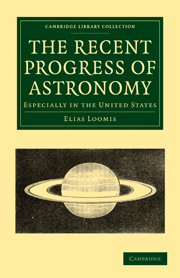Book contents
- Frontmatter
- PREFACE
- Contents
- CHAPTER I RECENT ADDITIONS TO OUR KNOWLEDGE OF THE PLANETARY SYSTEM
- CHAPTER II RECENT ADDITIONS TO OUR KNOWLEDGE OF COMETS
- CHAPTER III ADDITIONS TO OUR KNOWLEDGE OF FIXED STARS AND NEBULÆ
- SECTION I
- SECTION II
- SECTION III
- SECTION IV
- SECTION V
- CHAPTER IV PROGRESS OF ASTRONOMY IN THE UNITED STATES
- POSTSCRIPT
- Frontmatter
- PREFACE
- Contents
- CHAPTER I RECENT ADDITIONS TO OUR KNOWLEDGE OF THE PLANETARY SYSTEM
- CHAPTER II RECENT ADDITIONS TO OUR KNOWLEDGE OF COMETS
- CHAPTER III ADDITIONS TO OUR KNOWLEDGE OF FIXED STARS AND NEBULÆ
- SECTION I
- SECTION II
- SECTION III
- SECTION IV
- SECTION V
- CHAPTER IV PROGRESS OF ASTRONOMY IN THE UNITED STATES
- POSTSCRIPT
Summary
The last few years have been remarkable for the production of the largest telescope ever manufactured. Sir William Herschel constructed, with his own hands, telescopes of 20 and 40 feet focus, with which he made some of the most brilliant discoveries recorded in- the history of astronomy. But quite recently, the Earl of Rosse has completed a telescope still more gigantic than the largest of Sir William Herschel. He had previously constructed a telescope of three feet aperture, which received the highest commendation from. Dr. Robinson and Sir James South. In 1842, he commenced another of far superior dimensions, whose speculum was six feet in diameter, and weighed three tons. The materials of which it is eomposed are copper and tin, united in the proportion of fifteen parts of copper to seven of tin. The process of grinding was conducted under water, and the moving power employed was a steam engine of three horse power. The substance made use of to wear down the surface was emery and water, and it required six weeks to grind it to a fair surface.
The tube of the telescope is 56 feet long, and is made of wood one inch thick, and hooped with iron. The diameter of this tube is 7 feet. At 12 feet distance on each side of the telescope, a wall is built, 72 feet long, 48 high on the outer-side, and 56 on the inner, the walls being 24 feet distant from each other, and lying exactly in the meridian.
- Type
- Chapter
- Information
- The Recent Progress of AstronomyEspecially in the United States, pp. 196 - 201Publisher: Cambridge University PressPrint publication year: 2010First published in: 1856



